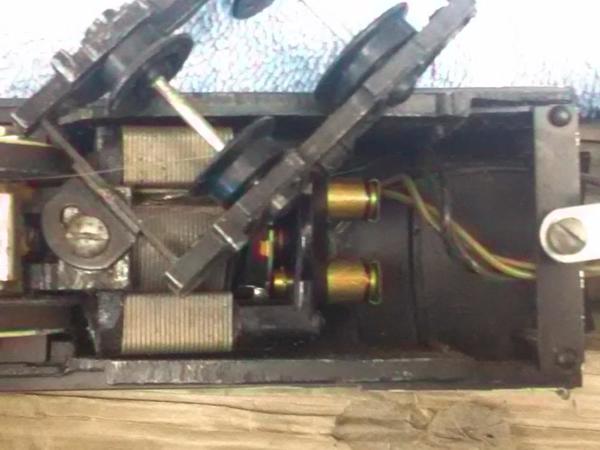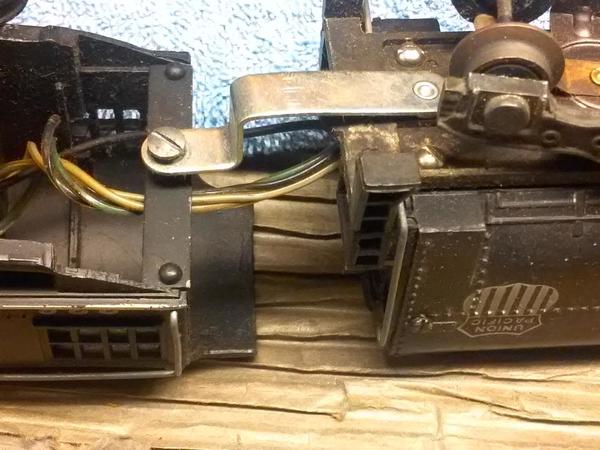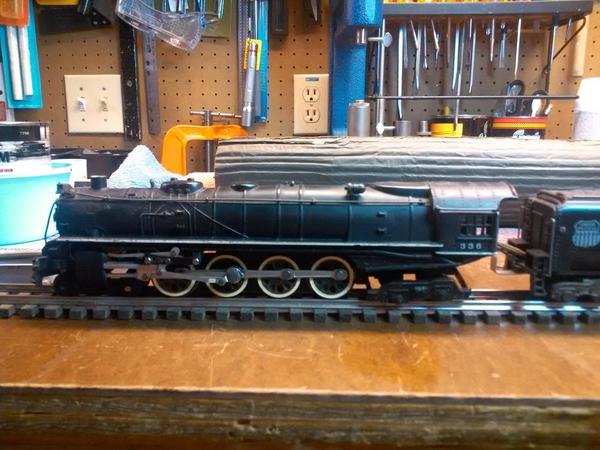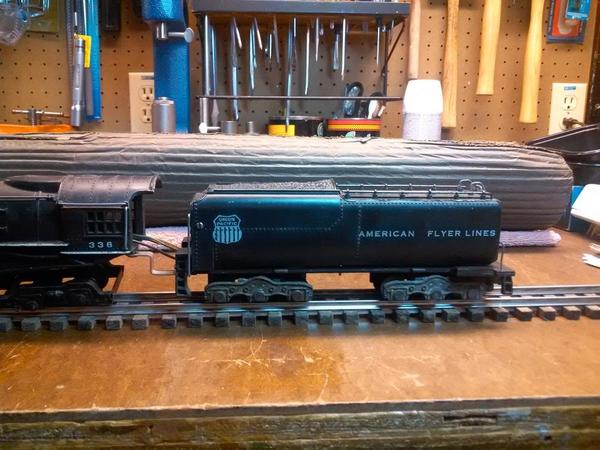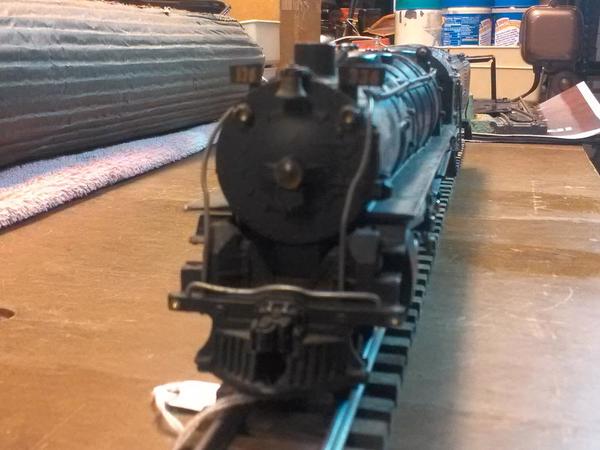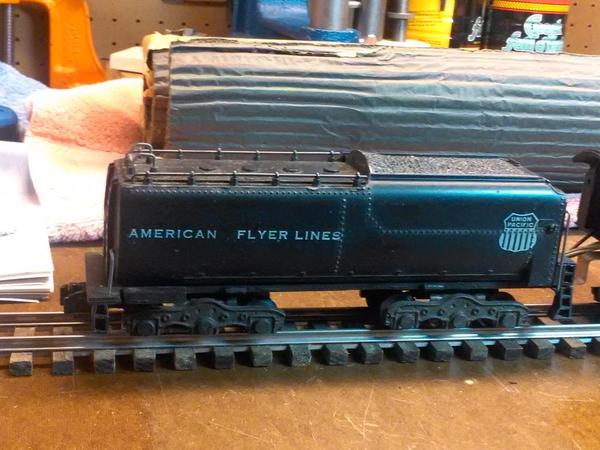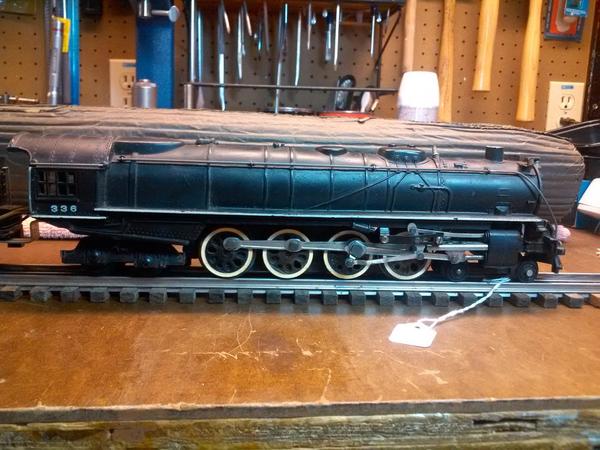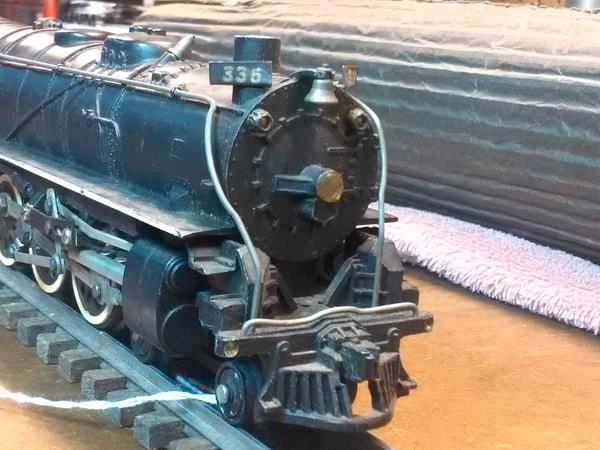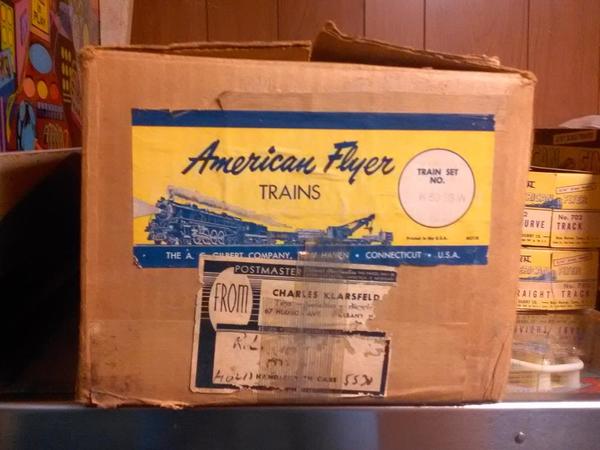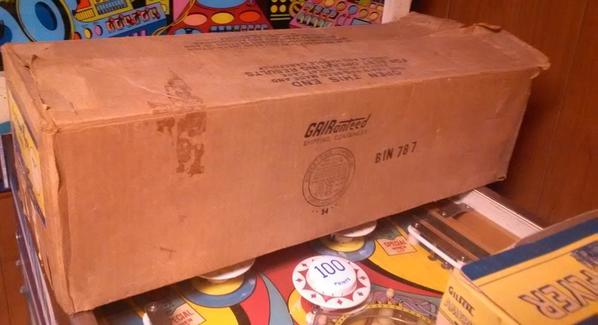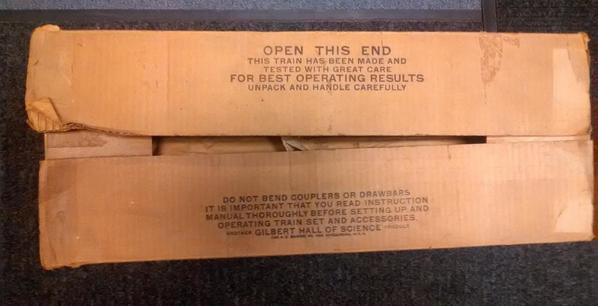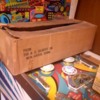I finally got a chance to take a closer look at the 1950's American Flyer 336 Northern that I recently acquired.
I am wondering whether the wiring between the engine and tender was redone.
The American flyer service manual indicates that the locomotive should have a terminal plate on the back of the engine, with a cloth covered wire bundle running from the tender to a fiber board plug assembly. (As I believe is common on Flyer steam).
The engine I purchased has a wire bundle, running directly from the tender to the loco, no terminal board. The wire has it's individual conductors insulated with colored plastic, which is then covered in a clear plastic, similar to what I've seen Flyer use in other places, like the 760 whistle control.
I see absolutely no sign that a terminal board was ever mounted to the back of the engine.
Looked on EBay. All but one engine seemed to have the traditional cloth covered wire and a terminal board.
One engine did seem to have the same setup- plastic coated wire bundle going directly from the tender to the loco.
What say the Flyer folks...... rewired or factory?
Replies sorted oldest to newest
I have at least one 336 like this, if I remember correctly some of the wires are grey and somehow green comes into possibly being another one.
Can you check the date stamp inside, I bet it will be a late production one and part of a possible cost cutting exercise.
i also have a 326 Hudson like this as well
Many engines were produced with direct connected rainbow wiring. I have a 282, 287 and 326 with rainbow wire, they are original. We would need to see some close up pictures to determine if that specific engine is original or rewired. I have not personally seen a 336 with rainbow wire, but I was not really looking for one.
Can you check the date stamp inside, I bet it will be a late production one and part of a possible cost cutting exercise.
It's my impression that I will have to separate the chassis and shell to see the date code. I am not ready to do that yet. This is my first AF Northern. ![]()
Sometimes if you are lucky you can shine a torch light into the boiler around the smoke gear and see the date. Otherwise they can be hidden under the field coil stack and the only way to find it is to remove the boiler shell.
Other than my 282 these engines are not quickly accessible, but at least for the ones I have the 282 with metal tender was 1952 production only. The 287 was 1954 production only. Not at all sure about the 326, it was not in a wrapper or box. As was said earlier, it may be later production such as 1957.
A picture would be nice. Generally the locos that are hard wired have gray and green plastic covered wires. The ones with the 4 or 5 pin plug generally have black or black/tan cloth covered wires.
I have a 336 with direct wiring. Black, green, and grey plastic coated wire together. An additional separate black wire also.
Rich
richabr posted:I have a 336 with direct wiring. Black, green, and grey plastic coated wire together. An additional separate black wire also.
Rich
Me too, and it's factory original direct wiring, i.e. no jack panel.
Thank you for all the replies / help with my American Flyer purchase. I will try to get some photos taken today, and try to see if the date stamp is visible without disassembly.
CW,
When Gilbert first moved the e-unit from the locomotive to the tender, they used a 4-conductor wire to a jack panel at the back of the locomotive. This allowed the tender to be disconnected from the locomotive. This resulted in the headlight being off and no current to the smoke unit when the locomotive was in neutral. When the locomotive first began to move, it took the smoke unit a few seconds to heat up instead of smoking immediately.
To correct this problem, they added a fifth wire that provided a direct hot lead from the track to the headlight and smoke unit. They still used the jack panel, however, which didn't make sense because you still have to un-solder the fifth wire at the a jack panel if you want to disconnect the tender. In 1955-1956, they ditched the jack panel and went to the direct wiring that you have.
How common is the set box, or American Flyer set boxes in general?
Some photos of the set box for my 336 are below:
Attachments
I had a quick look at some of the 336's on eBay and from what I can see, the direct wired ones also have the deep flanges on the drivers which I believed was always a later change.
What is curious is that your 336 is direct wired and looks to have the smaller flanges on the drivers. The question to ask is which year did Gilbert change from small flanged drivers to the deep/larger type?
I suspect that there has to be some documentation around when Gilbert went to direct wiring and flange changes which will explain some of these anomalies floating about.
Also, does anyone have a spare tender for a 336, I picked up an engine about a year ago but someone had taken the tender.
Lastly, what is the reason for Northern tenders commanding high prices as a separate item? Is it because of the earlier ones suffering frame rot or people wanting them for pre-war O gauge Northerns?
Yes, I have the original wrap for the locomotive, and boxes for most of the cars. I think that the only thing I am missing is the track. If there were any cardboard fitter pieces they are gone.
Thank you TrainDavid.
The set is a K5358W.
I only have a small number of American Flyer catalogs, but I do happen to have an early 1950's one that includes this set, so I do have a contents list.
The set came with one yellow straight track box, and one yellow curved track box. Also enough curves to fill the curved box, but I could not get the track to fit. (I think some of the track is bent) There were only four pieces of straight track. I do not have the catalog in front of me. I think the set came with 12 curves (one box), but I don't think it came with a full box of straights. Would they have included a partially filled box?
I didn't mention this earlier, but I know the person from whom I purchased the set. It was his childhood set. His wife rescued it from his parent's basement, and hoped he'd set it up. Never happened. They are downsizing now and needed to find it a new home. None of his family wanted it, so I offered to buy it.
Still, being that I am not that familiar with American Flyer, I have had questions about the items (and extras) that came with this train set. I appreciate all the help I've been receiving here.




